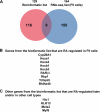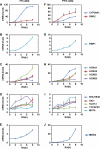Genome-wide in silico identification of new conserved and functional retinoic acid receptor response elements (direct repeats separated by 5 bp)
- PMID: 21803772
- PMCID: PMC3190930
- DOI: 10.1074/jbc.M111.263681
Genome-wide in silico identification of new conserved and functional retinoic acid receptor response elements (direct repeats separated by 5 bp)
Abstract
The nuclear retinoic acid receptors interact with specific retinoic acid (RA) response elements (RAREs) located in the promoters of target genes to orchestrate transcriptional networks involved in cell growth and differentiation. Here we describe a genome-wide in silico analysis of consensus DR5 RAREs based on the recurrent RGKTSA motifs. More than 15,000 DR5 RAREs were identified and analyzed for their localization and conservation in vertebrates. We selected 138 elements located ±10 kb from transcription start sites and gene ends and conserved across more than 6 species. We also validated the functionality of these RAREs by analyzing their ability to bind retinoic acid receptors (ChIP sequencing experiments) as well as the RA regulation of the corresponding genes (RNA sequencing and quantitative real time PCR experiments). Such a strategy provided a global set of high confidence RAREs expanding the known experimentally validated RAREs repertoire associated to a series of new genes involved in cell signaling, development, and tumor suppression. Finally, the present work provides a valuable knowledge base for the analysis of a wider range of RA-target genes in different species.
Figures










Similar articles
-
Retinoid regulated association of transcriptional co-regulators and the polycomb group protein SUZ12 with the retinoic acid response elements of Hoxa1, RARbeta(2), and Cyp26A1 in F9 embryonal carcinoma cells.J Mol Biol. 2007 Sep 14;372(2):298-316. doi: 10.1016/j.jmb.2007.06.079. Epub 2007 Jul 3. J Mol Biol. 2007. PMID: 17663992 Free PMC article.
-
Retinoic acid receptors recognize the mouse genome through binding elements with diverse spacing and topology.J Biol Chem. 2012 Jul 27;287(31):26328-41. doi: 10.1074/jbc.M112.361790. Epub 2012 Jun 1. J Biol Chem. 2012. PMID: 22661711 Free PMC article.
-
Biological and clinical implications of retinoic acid-responsive genes in human hepatocellular carcinoma cells.J Hepatol. 2013 Nov;59(5):1037-44. doi: 10.1016/j.jhep.2013.06.024. Epub 2013 Jul 2. J Hepatol. 2013. PMID: 23831118
-
History of retinoic acid receptors.Subcell Biochem. 2014;70:1-20. doi: 10.1007/978-94-017-9050-5_1. Subcell Biochem. 2014. PMID: 24962878 Review.
-
The negative side of retinoic acid receptors.Neurotoxicol Teratol. 2011 Nov-Dec;33(6):631-40. doi: 10.1016/j.ntt.2011.06.006. Epub 2011 Jul 13. Neurotoxicol Teratol. 2011. PMID: 21767634 Free PMC article. Review.
Cited by
-
Mechanisms of Feedback Regulation of Vitamin A Metabolism.Nutrients. 2022 Mar 21;14(6):1312. doi: 10.3390/nu14061312. Nutrients. 2022. PMID: 35334970 Free PMC article. Review.
-
All-Trans Retinoic Acid Induces TGF-β2 in Intestinal Epithelial Cells via RhoA- and p38α MAPK-Mediated Activation of the Transcription Factor ATF2.PLoS One. 2015 Jul 30;10(7):e0134003. doi: 10.1371/journal.pone.0134003. eCollection 2015. PLoS One. 2015. PMID: 26225425 Free PMC article.
-
Transcriptional-regulatory convergence across functional MDD risk variants identified by massively parallel reporter assays.Transl Psychiatry. 2021 Jul 22;11(1):403. doi: 10.1038/s41398-021-01493-6. Transl Psychiatry. 2021. PMID: 34294677 Free PMC article.
-
Differential Effects of Vitamins A and D on the Transcriptional Landscape of Human Monocytes during Infection.Sci Rep. 2017 Jan 17;7:40599. doi: 10.1038/srep40599. Sci Rep. 2017. PMID: 28094291 Free PMC article.
-
Mechanisms Regulating Stemness and Differentiation in Embryonal Carcinoma Cells.Stem Cells Int. 2017;2017:3684178. doi: 10.1155/2017/3684178. Epub 2017 Mar 8. Stem Cells Int. 2017. PMID: 28373885 Free PMC article. Review.
References
-
- Bour G., Taneja R., Rochette-Egly C. (2006) in Nuclear Receptors in Development (Taneja R. ed.) pp. 211–253, Elsevier Science Publishing Co., Inc., New York
-
- Duong V., Rochette-Egly C. (2011) Biochim. Biophys. Acta 1812, 1023–1031 - PubMed
-
- Samarut E., Rochette-Egly C. (2011) Mol. Cell. Endocrinol., in press - PubMed
Publication types
MeSH terms
Substances
LinkOut - more resources
Full Text Sources
Other Literature Sources

